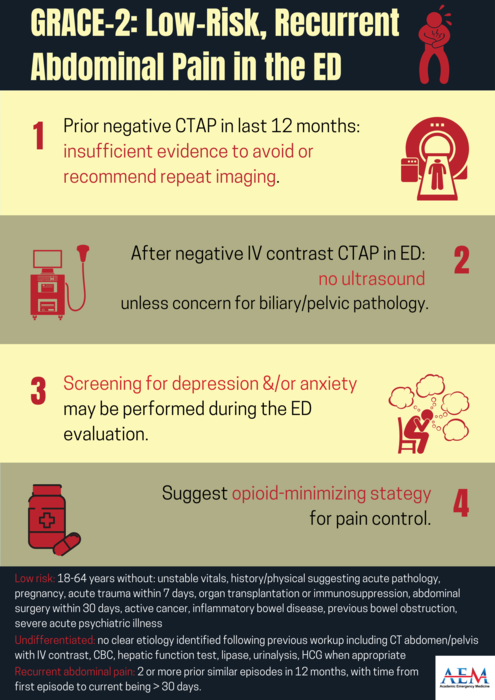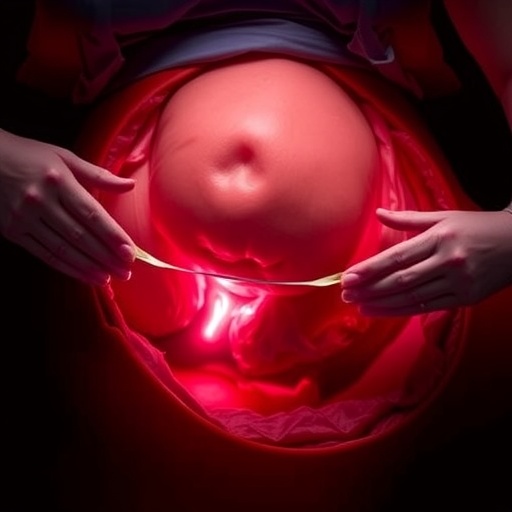The Society for Academic Emergency Medicine (SAEM) is pleased to announce the release of its second publication in a series of Guidelines for Reasonable and Appropriate Care in the Emergency Department (GRACE-2). The article titled Guidelines for Reasonable and Appropriate Care in the Emergency Department: Low-Risk, Recurrent Abdominal Pain in the Emergency Department will be published in the May issue of SAEM’s peer-reviewed journal, Academic Emergency Medicine (AEM).
A multidisciplinary panel of experts and a patient stakeholder assessed the certainty of evidence and strength of recommendations regarding four priority questions for adults presenting to the emergency department (ED) with low-risk, recurrent, undifferentiated abdominal pain. The panel reached the following recommendations (1) if a prior negative computed tomography of the abdomen and pelvis (CTAP) has been performed within 12 months, there is insufficient evidence to accurately identify populations in whom repeat CTAP imaging can be safely avoided or routinely recommended; (2) if CTAP with IV contrast is negative, they suggest against ultrasound unless there is concern for pelvic or biliary pathology; (3) they suggest that screening for depression and/or anxiety be performed during the ED evaluation; (4) they suggest an opioid-minimizing strategy for pain control.
To write this clinical practice guideline, the panel used Grading of Recommendations Assessment Development and Evaluation (GRADE) methodology, a framework used by 110 organizations from 19 countries for rating the quality of the best available evidence and developing transparent clinical practice recommendations.
GRACE-2 authors found that the quantity and quality of evidence were very limited, and even fundamental definitions of the population and outcomes of interest are lacking. Future research opportunities include developing clinically relevant and widely acceptable definitions of low-risk, recurrent, undifferentiated abdominal pain before quantifying the frequency of annual ED visits for this complaint, associated costs of care, and patient and provider preferences in terms of diagnostic certainty and therapeutic priorities.
The lead author of the study is Joshua Broder, MD, vice chief for education in emergency medicine at Duke University School of Medicine. Dr. Broder commented on the study findings,
“The GRACE-2 writing committee was focused on the common but challenging questions we confront every day in the emergency department. While the evidence we found was limited, we identified key areas for future research, and we hope the transparency of the process and our recommendations will help physicians and patients.”
The SAEM GRACE program addresses the best practices for the care of the most common chief complaints that can be seen on the tracking board of any ED in the country, based upon research and expert consensus. These guidelines are designed with de-implementation as a guiding principle to reasonably reduce wasteful testing, provide explicit criteria to reduce foreseeable risk, while defining sensible and prudent medical care. In addition to GRACE-2 for abdominal pain, SAEM GRACE teams have previously published guidelines for recurrent, low risk chest pain and are currently working on clinical practice guidelines for acute dizziness and non-opioid substance dependence.

Credit: CREDIT: KIRSTY CHALLEN, B.SC., MBCHB, MRES, PH.D., LANCASHIRE TEACHING HOSPITALS, UNITED KINGDOM
The Society for Academic Emergency Medicine (SAEM) is pleased to announce the release of its second publication in a series of Guidelines for Reasonable and Appropriate Care in the Emergency Department (GRACE-2). The article titled Guidelines for Reasonable and Appropriate Care in the Emergency Department: Low-Risk, Recurrent Abdominal Pain in the Emergency Department will be published in the May issue of SAEM’s peer-reviewed journal, Academic Emergency Medicine (AEM).
A multidisciplinary panel of experts and a patient stakeholder assessed the certainty of evidence and strength of recommendations regarding four priority questions for adults presenting to the emergency department (ED) with low-risk, recurrent, undifferentiated abdominal pain. The panel reached the following recommendations (1) if a prior negative computed tomography of the abdomen and pelvis (CTAP) has been performed within 12 months, there is insufficient evidence to accurately identify populations in whom repeat CTAP imaging can be safely avoided or routinely recommended; (2) if CTAP with IV contrast is negative, they suggest against ultrasound unless there is concern for pelvic or biliary pathology; (3) they suggest that screening for depression and/or anxiety be performed during the ED evaluation; (4) they suggest an opioid-minimizing strategy for pain control.
To write this clinical practice guideline, the panel used Grading of Recommendations Assessment Development and Evaluation (GRADE) methodology, a framework used by 110 organizations from 19 countries for rating the quality of the best available evidence and developing transparent clinical practice recommendations.
GRACE-2 authors found that the quantity and quality of evidence were very limited, and even fundamental definitions of the population and outcomes of interest are lacking. Future research opportunities include developing clinically relevant and widely acceptable definitions of low-risk, recurrent, undifferentiated abdominal pain before quantifying the frequency of annual ED visits for this complaint, associated costs of care, and patient and provider preferences in terms of diagnostic certainty and therapeutic priorities.
The lead author of the study is Joshua Broder, MD, vice chief for education in emergency medicine at Duke University School of Medicine. Dr. Broder commented on the study findings,
“The GRACE-2 writing committee was focused on the common but challenging questions we confront every day in the emergency department. While the evidence we found was limited, we identified key areas for future research, and we hope the transparency of the process and our recommendations will help physicians and patients.”
The SAEM GRACE program addresses the best practices for the care of the most common chief complaints that can be seen on the tracking board of any ED in the country, based upon research and expert consensus. These guidelines are designed with de-implementation as a guiding principle to reasonably reduce wasteful testing, provide explicit criteria to reduce foreseeable risk, while defining sensible and prudent medical care. In addition to GRACE-2 for abdominal pain, SAEM GRACE teams have previously published guidelines for recurrent, low risk chest pain and are currently working on clinical practice guidelines for acute dizziness and non-opioid substance dependence.
###
ABOUT ACADEMIC EMERGENCY MEDICINE
Academic Emergency Medicine, the monthly journal of Society for Academic Emergency Medicine, features the best in peer-reviewed, cutting-edge original research relevant to the practice and investigation of emergency care. The above study is published open access and can be downloaded by following the DOI link: 10.1111/acem.14495. Journalists wishing to interview the authors may contact Tami Craig at [email protected].
ABOUT THE SOCIETY FOR ACADEMIC EMERGENCY MEDICINE
SAEM is a 501(c)(3) not-for-profit organization dedicated to the improvement of care of the acutely ill and injured patient by leading the advancement of academic emergency medicine through education and research, advocacy, and professional development. To learn more, visit saem.org.
Journal
Academic Emergency Medicine
DOI
10.1111/acem.14495
Method of Research
Systematic review
Subject of Research
People
Article Title
SAEM Publishes New Guideline for Low-Risk, Recurrent Abdominal Pain in the Emergency Department
Article Publication Date
11-May-2022
COI Statement
The authors have no no significant conflicts.




